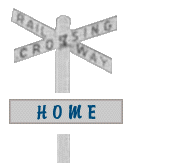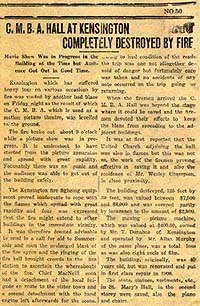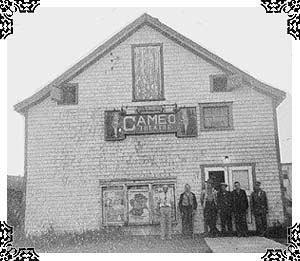








There's
a light in the hall tonight, Mary,
Now, what are they doing there?
We didn't have any hall, wife,
When you were so young and fair.
-- Turn-of-century Island verse
CMBA Hall | King George Hall | Cameo Theater
In 1906, the Catholic Mutual Benevolent Association purchased land in Kensington and built a hall, which immediately became an important location for events both religious and recreational. For over two decades, the upper level of the hall was the place where mass was held in Kensington, as the nearest Catholic church was located in Indian River. The priest from St. Mary's parish, Msgr. Daniel Gillis, celebrated mass at the CMBA hall from the time its doors opened until it was destroyed by fire in 1928.
The lower part of the building, on the other hand, hosted just about every kind of gathering imaginable, from prayer meetings and conventions to concerts, plays, and card parties. Due to the Irish heritage of most Kensington Catholics, St. Patrick's Day was always a festive occasion at the hall, and a speaker possessed of the traditional Irish eloquence would be found the recount the tale of Ireland's patron saint and how he chased the snakes out of his homeland. Affectionately dubbed 'The Concert,' these spirited celebrations would also feature music and monologues, as well as amateur melodramas with titles such as "My Wild Irish Rose" and "The Old-Fashioned Mother."
Another popular event was the basket or pie social, where baskets of food prepared and decorated by local women would be auctioned off for charity. If a young man took a shine to a particular girl in the community, he would have to find out how she had decorated her basket and then pay top dollar for it, guaranteeing that they would be able to enjoy it together. If the audience got the impression that a man was particularly set on winning a basket, they would deliberately bid against him and drive up the bid-- all in the interests of charity, of course. On the other hand, scrupulous wives would occasionally scrimp slightly on the decor of their baskets, so that their husbands would not have to pay an exorbitant price.
The man who was usually called upon to host the auction was Hugh Morrison, and he apparently had the trademark soft-sell down to a science. Morrison recalled an auction in the early 1900's when one of the items on the block was a chemical toilet with a sewage pipe jutting out of it, a device that would be an entirely unfamiliar sight to most area residents. When the object was offered, the bidding escalated between two ladies and an elderly gentleman, and neither party appeared ready to relinquish a claim to it. Not wanting to offend the ladies by bidding too aggressively, the gentleman leaned over to ask if they were really serious about purchasing the item. If not, he said, he would really like to have such a "nice looking little stove."
The CMBA hall was the location of the first
silent picture theater in Kensington, and the fantastic
images projected on the screen gave people a momentary
escape from routines which could seem a bit dreary by
times. William  Walker was the first to
operate the movie projector, and Miss Glennie Leslie
provided the piano accompaniment, complementing the
on-screen images with lively music. Waldin Darrach and
Thomas Donahue took over the operation of the theater
equipment and continued to run the shows until the hall
was tragically destroyed by fire on December 7, 1928. As
the adjoining article from the Summerside
Journal reports, the fire began at
9 o'clock as a show was playing to a packed house of
movie-goers. The projector overheated, causing the
celluloid film to ignite, and the blaze "spread from
the picture apparatus with great rapidity." Not only
did the audience get out "in good time," but
many actually stayed in the burning building to salvage
what they could. Before the fire got out of control, they
rescued the pews, the stations of the cross, the priest's
vestments, and even managed to move the piano! But by the
time two fire detachments arrived from Summerside to
help, the rest of the building was beyond the point of
salvation. The CMBA hall was not rebuilt, as the Catholic
community instead directed their energies toward the
construction of the beautiful Church of the Holy
Family. It still stands today, but
never shows any films.
Walker was the first to
operate the movie projector, and Miss Glennie Leslie
provided the piano accompaniment, complementing the
on-screen images with lively music. Waldin Darrach and
Thomas Donahue took over the operation of the theater
equipment and continued to run the shows until the hall
was tragically destroyed by fire on December 7, 1928. As
the adjoining article from the Summerside
Journal reports, the fire began at
9 o'clock as a show was playing to a packed house of
movie-goers. The projector overheated, causing the
celluloid film to ignite, and the blaze "spread from
the picture apparatus with great rapidity." Not only
did the audience get out "in good time," but
many actually stayed in the burning building to salvage
what they could. Before the fire got out of control, they
rescued the pews, the stations of the cross, the priest's
vestments, and even managed to move the piano! But by the
time two fire detachments arrived from Summerside to
help, the rest of the building was beyond the point of
salvation. The CMBA hall was not rebuilt, as the Catholic
community instead directed their energies toward the
construction of the beautiful Church of the Holy
Family. It still stands today, but
never shows any films.
 Not
to be outdone by the Catholics, the Protestant community
had a hall of their own-- King George Hall-- and it was
the second hall in town to show motion pictures once a
week. The Hall was originally built by the Orange Lodge
Organization as a location for their meetings. But as
with the CMBA hall, it soon became a place where all
manner of events were held, including many of the school
graduation ceremonies. The anti-Unionist
portion of the Presbyterian
congregation held services in the
hall between 1925 and 1927, as they had decided not to
follow their church in joining the United Church of Canada.
In 1927, the United Church congregation gave the
Presbyterian church back to the anti-Unionists, and they
moved into the King George Hall.
Not
to be outdone by the Catholics, the Protestant community
had a hall of their own-- King George Hall-- and it was
the second hall in town to show motion pictures once a
week. The Hall was originally built by the Orange Lodge
Organization as a location for their meetings. But as
with the CMBA hall, it soon became a place where all
manner of events were held, including many of the school
graduation ceremonies. The anti-Unionist
portion of the Presbyterian
congregation held services in the
hall between 1925 and 1927, as they had decided not to
follow their church in joining the United Church of Canada.
In 1927, the United Church congregation gave the
Presbyterian church back to the anti-Unionists, and they
moved into the King George Hall.
One of the most busiest days in the history of the King George Hall came in the 1950s, when the building was moved intact from its initial location next to the United Church on School Street to a location on Broadway Street. The large edifice was lifted from its foundations, and two long iron 'stringers'-- railway ties covered with axle grease-- were run all the way underneath it. Cables were affixed to the hall and then connected to a trestle with a team of horses, whose pulling allowed the building to inch along on the greased stringers. Several sets of rails were set end to end across the street. When the hall had finished sliding all the way along one of them, a couple of men would have to hurry behind to pick up the rail, douse it in a barrel of axle grease, and then place it in front of the building once again. While the hall may not have moved like greased lightning, these fast-moving workers must have been fairly well greased by the end of the day.
 Based
on the successful movie showings at the CMBA and King
George Halls, Ulysses and Viola Cameron decided to open a
full-time movie theater in Kensington. In 1945, the Cameo
Theater showed movies six nights a week. After one year,
the Cameron family sold the business to Kenneth Pidgeon,
who had some experience in the movie business before
buying the Cameo Theater. He had shown movies at the King
George Hall, and had then bought an old warehouse owned
by George Brookins and turned it into a theater. Weekend
matinees and Saturday evening showings were especially
popular at the Cameo. On Saturday night, people from the
surrounding countryside would come into town to buy their
groceries, and would always be sure to catch a show. The
approximately hundred-seat theater would be packed, and
even if the movie was not particularly good, everyone was
sure to stay awake, as rumor has it the wooden seats were
pretty uncomfortable. As the gentlemen pictured here
demonstrate, the Cameo was a much beloved hang-out in
town. But nothing lasts forever, and it seems that
Saturday nights were not enough to keep the Cameo going.
Pidgeon eventually closed the theater and turned it into
a motel.
Based
on the successful movie showings at the CMBA and King
George Halls, Ulysses and Viola Cameron decided to open a
full-time movie theater in Kensington. In 1945, the Cameo
Theater showed movies six nights a week. After one year,
the Cameron family sold the business to Kenneth Pidgeon,
who had some experience in the movie business before
buying the Cameo Theater. He had shown movies at the King
George Hall, and had then bought an old warehouse owned
by George Brookins and turned it into a theater. Weekend
matinees and Saturday evening showings were especially
popular at the Cameo. On Saturday night, people from the
surrounding countryside would come into town to buy their
groceries, and would always be sure to catch a show. The
approximately hundred-seat theater would be packed, and
even if the movie was not particularly good, everyone was
sure to stay awake, as rumor has it the wooden seats were
pretty uncomfortable. As the gentlemen pictured here
demonstrate, the Cameo was a much beloved hang-out in
town. But nothing lasts forever, and it seems that
Saturday nights were not enough to keep the Cameo going.
Pidgeon eventually closed the theater and turned it into
a motel.
Fire Hall | Post Office | Town Hall | Legion
